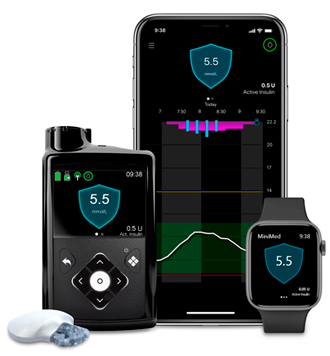Nice news
The National Institute for Health and Care Excellence (NICE) is an independent public organisation that provides guidance and advice to the National Health Service (NHS) on the use of new and existing medicines, treatments, and technologies.
The technology appraisal committee have found that hybrid closed loop (HCL) systems are a clinically and cost-effective option for managing type 1 diabetes in certain circumstances.
How did they do this? Through an MTA, or multiple technology appraisal, assessing all the HCL systems available. And the NHS is legally obliged to fund treatments recommended.
What does this mean for you?
Do you have type 1 diabetes and your HbA1c is above 58 mmol/mol (7.5%) or are you experiencing disabling hypo’s, despite using one of the following:
- insulin pump (CSII)
- real-time continuous glucose monitoring (CGM)
- intermittently scanned continuous glucose monitoring
Or are you a person with type 1 diabetes who’s pregnant or planning a pregnancy?
Then you could soon be able to access Hybrid Closed Loop (HCL) technology
Please note you must have the support of a trained multidisciplinary team experienced in using insulin pump therapy and CGM in type 1 diabetes.
Person or carer must:
- understand and be able to use the hybrid closed loop system
- attend a type 1 diabetes structured education programme
What is a Hybrid Closed Loop System?
A HCL system, is a type of insulin pump that uses a closed loop system to automatically adjust insulin delivery based on a person's sensor glucose levels.
The system includes:
A continuous glucose monitor (CGM) that measures glucose levels
An insulin pump that delivers insulin
And a control algorithm that adjusts insulin delivery based on the CGM readings
Replacing the need for multiple injections by delivering rapid acting insulin continuously 24 hours a day.
The goal of a HCL system is to provide more precise and personalised insulin delivery, which can help people with diabetes better manage their glucose levels and reduce the risk of complications .
Why would you want to use HCL technology?
Automatically manage your glucose levels, every 5 minutes, 24/7, HCL systems, such as the MiniMed™ 780G, constantly monitor and adjust insulin delivery. This means more control, with less effort1.
What other benefits do HCL systems offer:
The ADAPT study (using the MiniMed™ 780G System) reveals you can:2
Reduce HbA1c by 1.4% vs. MDI٨٨
Have a +27% increase in Time in Range without increasing time in hypoglycaemia§
Spend +6 hours more in good control vs. MDI.٨٨
Gain 30% more Time in Range during the night§
Medtronic MiniMed 780G Hybrid Closed Loop System

MiniMed™ 780G system with SmartGuard™ technology.
Our most advanced insulin pump system with SmartGuard™ automation for self-adjusting basal delivery with autocorrection
Now with Guardian™ 4 sensor.
New! Now compatible with Apple® Watch.
Consultees and commentators can appeal the NICE committee’s decision during the next three weeks. Final NICE HCL MTA guidance is expected to be published in December 2023
References:
- * Refer to System User Guide - SmartGuard™ feature. Some user interaction required.
- ^^ In the study subjects used Multiple Daily Injections + Intermittently scanned CGM
- § Compared to MDI + isCGM
- 1. Carlson AL, et al. Diabetes Technol Ther 2022;24(3):178 - 189.
- 2. Choudhary P, et al. Lancet Diabetes Endocrinol. 2022;
doi:10.1016/S2213-8587(22)00212-1.
UK-IPT-2300132
